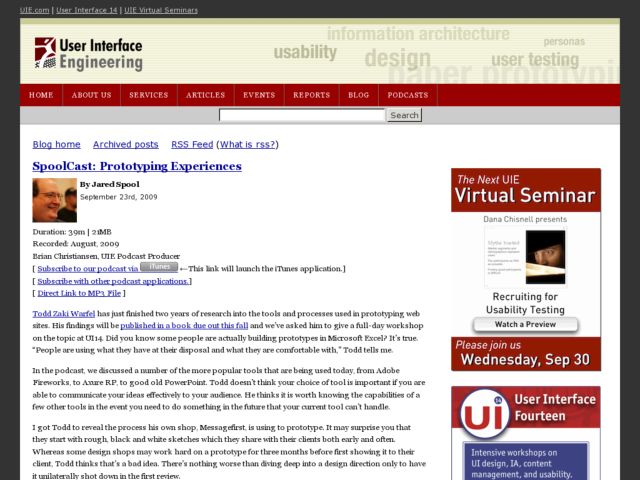Jared Spool talks with Todd Zaki Warfel about his forthcoming Prototyping book to be published by Rosenfeld Media, and got him to talk about his 2 years of research while working on the book.
Todd's firm, Message First, utilizes prototypes as a core element of the design process and has been giving a series of presentations and workshops recently to describe his research into the different prototyping practices of UX pros, and talk about the utility of the prototype. He engages clients early on in generating ideas, and uses the prototype to quickly get something in front of them that comes as close to the experience and behavior they might expect from their product. He provided a little bit of insight into their process.
It may surprise you that they start with rough, black and white sketches which they share with their clients both early and often. Whereas some design shops may work hard on a prototype for three months before first showing it to their client, Todd thinks that’s a bad idea. There’s nothing worse than diving deep into a design direction only to have it unilaterally shot down in the first review.
Instead, you need to get your client to give you lots of feedback very early in the process, starting with basic and rough sketches. It will save both sides a lot of time, effort and frustration. Once the design direction is solidified, Todd and his team move their prototypes into color and interactivity. The Messagefirst crew is now often jumping straight to HTML, CSS and JavaScript for the higher fidelity mockups.
One of the things I took away from this talk was that the best prototyping tool is the one that your most familiar with and know how to exploit to communicate the ideas. That said, there comes a point where the tool you use, whether it's Visio or OmniGraffle, Powerpoint or Excel, shows its limitations at communicating well enough. And this is why so many people jump more quickly to HTML prototypes.
This is essentially where I am today. I'm strong enough in the tools I use and have extended them beyond the capabilities they were created for. But what Todd and his team are doing makes sense. He engages clients early on with sketching exercises, and continues to ideate and refine on paper until they have a strong direction, and then they begin to demonstrate the ideas in a format that feels like the product.
http://www.uie.com/brainsparks/2009/09/23/spoolcast-prototyping-experiences/
